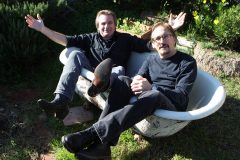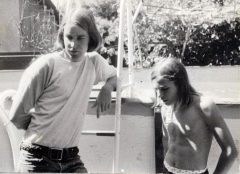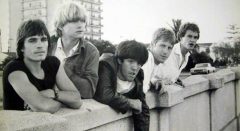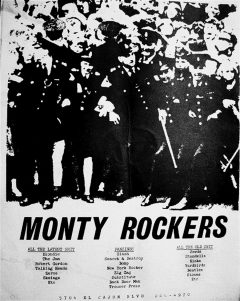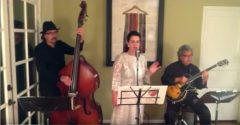Cover Story
Wait! You guys are still here? The Matching Musical Journeys of Jef and Joel Kmak
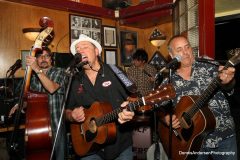
Shawn Rohlf & the Buskers at the Ould Sod: Jef, Shawn, T. Bone Larson, Joey Harris. Photo by Dennis Andersen.
Reading through Jef and Joel Kmak’s musical resume could be categorized as aerobic exercise: Screaming Chickens, Queenie, Dan McLain’s other early projects. Mutt, Blonde Bruce, Hitmakers, Crawdaddys, Saint James & the Voodoo Rockers, Comanche Moon, Joyce Rooks, the Beat Farmers (…and everything Jerry Raney’s cooked up since), the Penetrators, the Flying Putos, Powerthud, Joey Harris, Skid Roper, the Big City Hicks.
Out of breath yet? I’m just getting started!!!
They’ve been called the rhythm section from hell–one playing bass, one playing drums. And the family home on Chase Avenue in El Cajon, with its constant pulse of band rehearsals emanating from the garage, has gained its own mystique as generations have stopped to read the cryptic inscriptions “sympathy for the devil” and “mutt” inscribed in the sidewalk.
The Kmak brothers have held down the backline for some of San Diego’s best known rock, punk, country, roots, and Americana bands, which has put them in the middle of the web of musicians who have defined San Diego’s cow punk scene for the past 40 years. As one anonymous old-school cow-poker puts it, they’re “impeckerable.”
“Dad and mom had a big Victrola,” says Joel, “they used to play for us kids! Dad bought mom a piano in 1967. Big upright grand. She took lessons but soon Jef took it over. Then later Dan McLain, the future Country Dick Montana. It still has the cigarette burns Dan put on it. He could get away with anything at my house my parents loved him so. He used to play ‘Alley Cat’ for my dad.”
“Our parents were very supportive,” adds Jef. “They were always there for us and our friends. Going into debt to help us buy instruments. When the music bug hit, I wanted to play the trumpet in the San Diego Youth Symphony. But the director went to my Mom and said, ‘Honestly, with those teeth, he’ll never be much of a trumpeter. But would l be interested in playing the upright bass?’”
Jef, the older of the two, began playing guitar and bass as did many young kids caught in the tide of the British Invasion. “When l heard the Beatles on Ed Sullivan, I went out and got an electric guitar. But one day l was looking at a fan magazine and noticed Paul McCartney’s guitar only had four strings. I rode my bike down to Valley Music, threw the magazine on the counter and said, ‘What’s up with this?’ They told me it was a bass guitar, tuned like an upright string bass. That was it for me!”
Joel picked up the drums a little later: “As soon as I started playing drums, we were already forming bands and looking for gigs. I remember getting the drumming bug from my sister, Janet. Before the Beatles she would play ‘Sugar Shack’ by Jimmy Glimer and the Fireballs. Early Beach Boys. The Castaways. Freddy Cannon, too. But when the Beatles hit, she was all in, then Cream, the Doors, Jimi, the Stones. After hearing the stories about Gene Krupa and seeing the Beatles, I decided the drums were for me.”
“We practiced together,” says Jef. “Joel’s drums and my amp were set up next to each other in our bedroom.”
Adds Jef, “There weren’t DJs. If you wanted music at your party or function, you hired a band. So, l had to learn everything to cover all the bases: parties, dances, and weddings.”
Their first experience on stage came performing as part of the band at Christ the King Church, a famously liberal congregation in Southeast San Diego that the Kmak family was part of. Around this time, Christ the King made national news when several sailors protesting the Vietnam War went AWOL and sought sanctuary inside the church. As a standoff ensued, the church was surrounded by FBI and SWAT officers. “It was a small church my parents started going to in 1967,” says Joel. “Nathan East was the bass player! The East family had a rep even back then!”
Once in high school, the brothers, always with an eye on booking shows, began playing Grossmont and El Cajon High School dances. It was at this time that they met a fellow Grossmont student named Dan McLain, who was fronting a band called the Screaming Chickens, which, as later years might justify, dressed like farmers on stage.
“I joined one band with Dan,” says Jef. “But they fired me for having a girlfriend [no chicks, man] so I met some new people and formed a glitter-prog band called Mutt. I was in Mutt throughout the early ’70s. In high school I was a big blues guy. Later on, I was hit by the glam rock bug. Bowie, Mott the Hoople, Sweet. We used to wear satin outfits and platform shoes. I started to henna my hair orange. But we used to get in trouble with fans, because we also listened to the Band and Muddy Waters.”
Mutt rose to the top of the San Diego scene, selling out local venues including SDSU’s Montezuma Hall. Finally, they headed to L.A., where they were wooed by Polydor, Atlantic, and Electra. But, sadly, the band was never signed and all but broke up by 1976.
Meanwhile, says Joel, “It was 1972 and Glory with Jerry Raney was the biggest band in San Diego. A little older, louder, more dangerous! Way better than we were. We had a band called the Shake Band, playing covers of early Fleetwood Mac, Savoy Brown, Yardbirds, Kinks, and Chuck Berry. The band consisted of me, Jef, Brian Quinn, Brian Barto, Steve Kelly, and Dan on electric piano. We also had a band called King Righteous and the Royals, playing nothing but 1950s–Sha Na Na stuff. “
Then, Joel and McLain formed Queenie, a band dedicated to “Stones, Beatles, and Kinks B-sides.” With Joel on drums and McLain on upright piano, Queenie continued circuiting high school dances. At this time, McLain also rose up as the impresario of the local garage rock and burgeoning punk scenes. Musicians such as Ron Silva, Scott Harrington, Steve Kelly, and Chris Sullivan came into the fold forming the nucleus of such future bands as the Penetrators, the Crawdaddys, and the Hitmakers. As the 1970s crept forward, the Lion’s Club in North Park became the home turf where these bands held court.
Says Joel, “We did Kinks, Beatles, Rolling Stones. Queenie got the gigs! We quickly decided it was the bars and clubs we wanted play, even though no one was 21! A biker bar called Mothers. Scary! We even opened for Glory a few times at J J’s! That was Jerry Herrera’s club on the Pacific Coast Highway before he opened the Spirit Club in 1976. I think this was 1974. The plan for Queenie was to move to L.A. In 1974 I graduated a year early from Grossmont High School so we could move. We even had a band house. But, that fall the band broke up. So I went to Grossmont College.”
Once Queenie had run its course, McLain, switching from piano to drums, went on to form the Crawdaddys and the Penetrators. McLain also opened a record store–Monty Rockers–in the San Diego State area. Joel, meanwhile, joined the Hitmakers, asking Jef, who had just left Mutt, to join too. This was 1977 and the Ramones had just turned the local music scene on its head. Glitter was out. Punk was in.
The Hitmakers were soon reigning kings of local punk along with the select stable of bands that played the Lion’s Club. In 1978, the Hitmakers toured the East Coast including New York’s Max’s Kansas City and Boston’s Rat Cellar.
Joel says, “The Hitmakers start playing regularly between San Diego, L.A., Las Vegas, and San Francisco. We released an EP, It’s Only Sad, and were written up in Creem magazine! My favorite show of the tour was opening for Johnny Thunder and the Heartbreakers on July 4, 1979 at Max’s Kansas City. My favorite drummer Jerry Nolan [of New York Dolls fame] and David Johansen stopped by for a chat. We got a great write up in the New York Rocker and opened for the Pretenders at the Marquee Club in London.”
Soon, they headed to London in search of a contract. In England, they ran into problems with British Immigration over their visa status and, unable to work, were forced to return home. Unfortunately, the band didn’t survive the turmoil and broke up in 1980.
Also at this time that Daniel Monty McLain and Joel started collecting records. Back then there was no internet so if you wanted to hear anything not being played on the radio you had to find the record. Plus, there were no oldies stations, no R&B stations, just the FM radio. Monty Rockers Records soon opened becoming the young scene’s “punk rock hangout.”
In these years, the mold was cast: both brothers dedicated themselves to the harder edge of what was now being called New Wave. This harder edge stuck to more ’60s sound preferring, for instance, the Vox Continental organ to the cheap synthesizers that would come to define New Wave in the ’80s. They also stayed true to earlier influences like electric blues. For some time, McLain had been harboring a Johnny Cash collection, an anomaly in punk circles. The country baritone of Cash, along with other country and country-tinged singers, from Hank Williams Sr. to Gram Parsons, soon began festering in the post-punk circles that would define the San Diego Sound.
Returning from England, the brothers went their separate ways musically. Joel joined the Crawdaddys. Newly married, Joel also chose to come home to San Diego to raise his family. Around 1980, Jef formed Johnny Danger and the Little Strangers, the first of many projects over the years in which Jef would step into the front line as vocalist and principal songwriter.
“On my return,” Joel says, “I found out that the little band I had left to join the Hitmakers was now the biggest band in San Diego! I started playing with the Crawdaddys, a band McClain had been drumming for. I also formed a band with Jef called the Mega Band as we had two drummers, backup singers Tai and Holly and a few others.
It was good being back home in San Diego with my wife, Tai. We had been together since 1976 and our daughter, Jessika, who was born in 1981.”
By now, the Kmak brothers had a solid reputation and younger players were looking up to them. Charles Maynes of the Seventh remembers: “Jef and Joel were some of the first San Diego rock stars. I remember seeing the Hitmakers often at the old venues, the Skeleton Club downtown and Straita Head Sound in the College area.”
Joel continued playing in the tightly knit scene, rotating between the Penetrators, Joyce Rooks, Blonde Bruce. The Sidewinders, Farage Brothers, and DFX2 were also part of this inner circle. Many of these bands were held in orbit by Mclain’s poker games and Sunday afternoon softball games at Grossmont High. Led by the Sidewinders, the scene found a home at Mandolin Wind [later Hamburger Mary’s in Hillcrest] where a “Cavalcade of Stars” would function as part open mic and part jam session, a place for those drawn to the rootsier, bluesier, rockabilly edges of post-punk. Out of this scene, McLain morphed into Country Dick Montana and soon the Beat Farmers were born.
Jef left for the Bay Area in 1982 where he formed Hank’s Army, which, like Mutt a decade before, was right on the heels of a major recording contract. After Hank’s Army’s two-year flirtation with fame, Jef returned to San Diego–the Kmak’s garage in El Cajon to be specific–and dedicated himself to producing. With only an eight-track in the now-insulated garage, Jef went on to produce a number of local artists including Guy Goode and the Decent Tones, the Seventh, Joseph D’Angelo, the Penetrators, and Joyce Rooks.
Some of the girlfriends of the Seventh lived next to the Kmak house on Chase Avenue. So Charles Maynes was there a lot. “Jef had his studio there and recorded the Seventh. It was about the same time that the Beat Farmers broke, which the Seventh famously lost to in a battle of the bands at Lehr’s Greenhouse.
“We got to spend a fairly good deal of time with Jef who had set up a small recording studio in the garage there. He graciously allowed us to record there and was a gigantic mentor as far as we were concerned; it was like Paul McCartney being your neighbor. Jef had this amazing open mind to music, and loved seemingly ever form of it–he was the first guy we knew who had a lap steel guitar–and his creative vision was truly an inspiration to us in every single way. It seems sort of bizarre in so many ways to think back on that time, but it was so remarkably precious, and awesome to live that moment in San Diego’s musical history,” Maynes says.
The San Diego scene that first began at McLain’s record store, poker parties, and softball games was attracting national attention. Mojo Nixon had penetrated MTV airwaves and the Beat Farmers were gaining a national cult following, including critical praise from the likes of Dwight Yoakam and Kevin Costner, TV appearances at the CMAs and on David Letterman, and a degree of mainstream recognition.
According to Joel, “The San Diego music scene was really changing from punk to cow punk thanks to Country Dick Montana and the Snuggle Bunnys. Mojo Nixon and Skid Roper too were putting San Diego on the map. Buddy Blue had the Jacks going with Chris Sullivan, Jack Pinney of Glory fame, and Joe Longa. Around 1985-86 I started attending the Cavalcade of Stars, hosted by my friends Douglas and David Farage, the evil twins from DFX2 as Dan called them. It was held every Thursday night at the old Mandolin Wind. Through the course of the evening you could witness the Sidewinders back up Country Dick, Joey Harris, Mojo Nixon, Paul Kamanski, members of the Dead Milkmen, Bobby Chevrolet, Mitchel Cornish, Tomcat Courtney, and others. I had to get in on this!”
For five years, from 1986 through 1991, Joel held down the drum throne for Paul Kamanski in Comanche Moon. Kamanski, best known as the songwriter of Beat Farmer classics “Bigger Stones” and “Hollywood Hills,” utilized Comanche Moon to showcase his skills as a front man and his ongoing talents as a songwriter. Comanche Moon soon gained its own local following, opening for Chris Isaak, the Georgia Satellites, Molly Hatchet, and the Beat Farmers while sharing the bill on occasion with Mojo Nixon. At this time, Joel fell heavily into country music and even played for a short while with the Michelle Rose Band.
In 1989, Jef married and returned to the Bay Area where he played with a number of people including Village on Fire, Judy Baker, and the San Francisco Blues Band featuring two older blues musicians: Willie Pitts and Memphis Dave. During this period, Jef got a taste of the “real thing” as he followed Pitts and Memphis Dave into the all-black blues clubs and house parties in Oakland and the East Bay.
In 1992, Jef returned to San Diego, and the brothers played together for a time with Saint James & the Voodoo Rockers, an outfit led by James Wood, brother of Warren Zevon’s former guitarist John Wood.
Then in 1995, the larger-than-life Country Dick Montana died. Joel had already been filling McLain’s shoes as far back as the Penetrators. He had also sat in for Dan on a number of Beat Farmers’ shows. So, when Jerry Raney picked up the pieces of the now-dissolved Beat Farmers, it was only natural that he would call on Joel to play drums. With original Beat Farmer Buddy Blue back in the fold, the new band Raney-Blue started gigging in 1996 with Jef on bass and Joe Longa on keyboards.
In 1997, the second post-Beat Farmer band, Powerthud, was formed with a near-identical lineup as Raney-Blue. In this new band, however, Beat Farmer Joey Harris joined and Buddy Blue stepped away. It was with these two bands that the Beat Farmer legacy continued and grew in new directions. Raney-Blue showcased its two namesakes. And Powerthud featured Joey Harris. All the while, Jef and Joel provided the rhythm section for both bands.
The two bands even united on occasion to play Beat Farmer reunions in 2000 and 2001. And Beat Farmer reunions continue to this day, albeit without Country Dick or Buddy Blue.
In 2002 with the departure of Jerry Raney, Powerthud evolved into the Joey Show in which Harris played ringmaster to a number of guest artists including Gregory Page, José Sinatra, Sara Petite, the Truckee Brothers, Robin Henkel, the Coyote Problem, and the late John Stewart. When not backing up guest artists, the Joey Show became Joey Harris & the Mentals, which to this day includes Jef, Joel, and the late Mighty Joe Longa.
In 2003, Jerry and Buddy reformed Raney-Blue into the Flying Putos with Rolle Love on bass and Joel still holding down the drums. The Flying Putos finally settled on the simple yet nostalgic name: the Farmers. The Farmers still remain together despite the death of Buddy Blue in 2006.
In the 50 years since they first picked up their instruments, the Kmak brothers have seen a lot. And, what’s more, they’ve seen much of it together. Yet, despite this symbiotic relationship, the brothers are distinct individuals with very different visions. On one hand, Jef is the more introspective. A guitarist and singer in addition to his skills on bass, Jef has written many songs and fronted bands as noted earlier. Jef’s tastes, although grounded in rootsy rock, also span everything from Big Band and jazz to acoustic and folk. The Big City Hicks, with his wife, is proof of Jef’s diversity. “I’m always up for new projects. I’m looking to do a post-modern jukebox type of band with Topher Williams. He’s the sax player with the band the Tighten Ups. My philosophy is to do what the music demands–to play what the music needs, and make everybody else sound better. I do like the occasional solo, but in general, that’s it.”
“My wife and l have a jazz trio called Hot Buttered Buscuit,” adds Jef. “We play songs from the ’20s, ’30s, and ’40s. I play the upright bass in that band. It’s a fun little group. My son and nephew both play. My nephew, Josh, had Shady Francos. You can hear them at the beginning and end of the TV show Sound Diego. His latest project is Creepseed. My son is working on an album of original songs. My daughter is a visual artist. She is going to school to get an art degree.”
Joel, on the other hand, is forever the hard-hitting rock drummer. Known affectionately as “Bongo” to all, Joel has honed the singular craft of banging out good time rock ‘n’ roll. Of course, “rock ‘n’ roll” is a big term, incorporating the American panorama and Joel’s own 38 years behind the drum kit. But, when it comes to beating those drums with singular abandon, nobody in town carries the pedigree that Joel does.
Joel says, “Way back in the ’70s big drum sets were ‘in.’ I always used a small trap kit like Charlie Watts even when it was out of style. Less is more. People have told me through the years I get a lot of miles out very little. So I guess through the years I’ve learned or perfected a style that can be flashy and simple at the same time. Let the kit do the work I’ve learned. Don’t over work it. Relax, baby. Have fun. I’ve never really gotten nervous before a show, even the big ones, because there is nowhere else I’d rather be!”
Yet in the end, there are distinct threads that continually bring the Kmak brothers together. They are both strong family men. They run a frame company together. And, they still migrate back to the garage on Chase Avenue in El Cajon.
“Even though Jef and I have not been in the same band since 2006,” says Joel, “we still cross each other’s paths musically, be it sitting in with each other’s bands or playing a Beat Farmer reunion. It’s still the same; we pick right up where we left off. I have a dream of one day forming a Kmak Attack band along with Jef, our wives, sons, daughters, nephews, and even sons-in-law, maybe in our garage (the old garage on Chase Avenue in El Cajon)! Or maybe a Fleetwood Mac tribute band called Fleetwood Kmak!”
Adds Jef, “The connection is always there. And, yes, we’re still here!”






